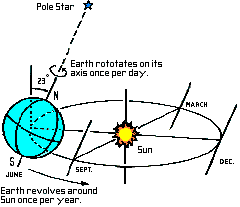Fig. 1 Motion of Earth around Sun
Fig. 2 Motion of the Moon
|
The movements this model represents are shown diagrammatically in Figures 1 & 2 on the left, and in the table below. When the model is in motion, the seasons of the earth are easily appreciated, and eclipse of the sun and moon are also correctly represented. Because the Moon's orbit is tilted at 5 degrees, it rises and falls, approximately once a month, through the plane of the earth's orbit round the sun. Only when the moon is actually in this plane at the same time as being in line with the sun and the earth can an eclipse occur, which is why this plane is called the ecliptic. |
Movements shown in this model 1. Earth revolves the sun once per year. The plane in which it moves is the ecliptic. 2. Earth rotates on its own axis, once per solar day, 365.26 days per year (in model 364.50). 3. Earth's equator is inclined at 23.5 degrees to the ecliptic. Its axis points in a constant direction in space, to the Pole star. 4. Moon revolves round Earth in 29.5 days (in model 29.6 days). 5. Plane of moon's orbit is inclined at 5 degrees to the ecliptic. This plane is nearly constant in space, but its pole rotates slowly backwards, one revolution in 18.6 years (in model 19.0 years). |


 Part 143
Part 143